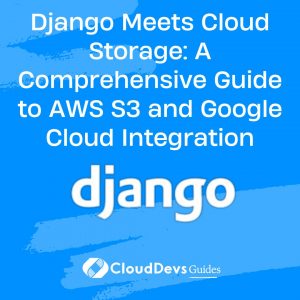Django Meets Cloud Storage: A Comprehensive Guide to AWS S3 and Google Cloud Integration
In today’s digital landscape, efficient data storage and management are critical for web applications. Django, a high-level Python web framework, simplifies the creation of complex, database-driven websites. However, when it comes to handling large amounts of data, especially media files, integrating cloud storage solutions like Amazon Web Services (AWS) Simple Storage Service (S3) or Google Cloud Storage (GCS) can greatly enhance your application’s performance and scalability. You can hire Django Developers for your projects to ensure greater success.
Table of Contents
1. Why Integrate Cloud Storage with Django?
- Scalability: Cloud storage services offer unparalleled scalability, making them ideal for applications that need to handle varying amounts of data.
- Reliability and Availability: These services provide high durability and availability, ensuring data is safe and always accessible.
- Cost-Effectiveness: Pay-as-you-go pricing models can reduce costs compared to traditional hosting.
2. Integrating Django with AWS S3
- Setting up AWS S3
– Create an AWS account and set up an S3 bucket.
– Configure bucket settings, including permissions and policies.
- Django Configuration
– Install `boto3` and `django-storages` libraries.
– Configure `settings.py` to use S3 as the default file storage system.
– Handle static and media file storage in Django.
- Security and Access Management
– Using IAM roles for secure access.
– Generating and managing access keys.
Further Reading and Resources: AWS Documentation on S3 Integration
3. Integrating Django with Google Cloud Storage
- Setting up GCS
– Create a Google Cloud account and set up a GCS bucket.
– Configure bucket settings, including permissions and lifecycle policies.
- Django Configuration
– Install `google-cloud-storage` library.
– Modify `settings.py` to integrate GCS with Django.
– Handling of media files and backups.
- Authenticating with Google Cloud
– Understanding and setting up service accounts.
– Using JSON key files for authentication.
Further Reading and Resources: Google Cloud Storage Documentation
4. Best Practices for Cloud Storage Integration
- Data Security: Implement encryption and proper access controls.
- Performance Optimization: Use CDN configurations for faster data delivery.
- Cost Management: Monitor and optimize data transfer and storage costs.
Conclusion
Integrating Django with cloud storage solutions like AWS S3 or GCS not only enhances the functionality and performance of your application but also ensures scalability and reliability. By following the steps outlined in this article, developers can efficiently integrate these powerful storage solutions into their Django projects.
You can check out our other blog posts to learn more about Django. We bring you a complete guide titled Django Real-time Alerts: A Push Notification Guide along with the Master Real-Time Communication in Django Apps with WebSockets and The Essential Guide to Social Logins in Django with OAuth and OpenID which will help you understand and gain more insight into the Django programming language.
Table of Contents







